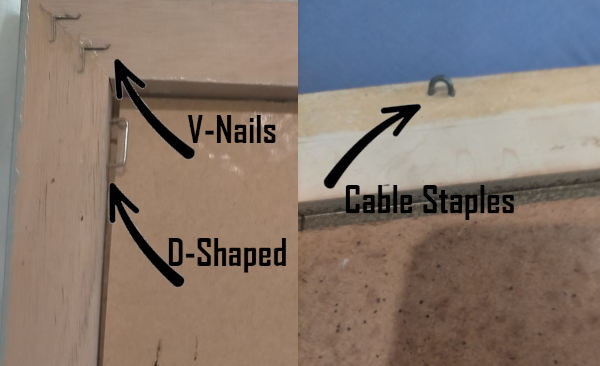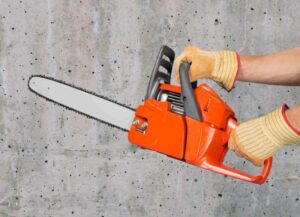There is an endless variety of staples currently on the market all used for different projects and purposes. Choosing the right style for your specific task can often feel overwhelming when you’re not an expert or when you are a newcomer trying to learn a new skill. But do not fear, this article will cover some of the most commonly used staples for picture framing and how these can be used to suit your exact framing needs.
The most common staples used for picture frames are the standard D-Shaped staple, V-Nails, and Cable Staples. Staples come in a range of widths and lengths, with 4mm and 6mm legs being the most common length. Generally, the softer the wood type, the longer the staple needs to be to hold the frame.
Types of Picture Frame Staples
Staples come in a range of styles which allow you to customize how you use them to build your frame and how they appear visually. Staples used for framing are far more robust than those used for paper which is where people normally encounter staples in their everyday lives.
The Versatility of D-Shaped Staples for Picture Framing
D-Staples or regular ‘flat crown’ staples are very adaptable and can come with a variety of helpful features which allow for different parts of the frame to be secured together.For instance, D-Staples are often formed into a ‘chisel’ shape which allows for easier penetration into the wood. On the other hand, ‘divergent’ staple legs deviate into the wood in opposite directions for a better hold, a method frequently used for hardwoods.
Additional uses for D-staples include backing the frame. Staples can be placed around the edge of the frame in order to secure the backing material placed on top of your image. This includes attaching materials such as cardboard or MDF if your image becomes loose or unstable over time.
V Nails to Hold Picture Frame Corners Together
V-nails can be used to join a frame together even more deeply. Sharp at one end and dull at the other, the sharp end is easily pushed into the corners of the frame to lock your creation into place where the wooden corners meet each other. These differ from ordinary staples because they are much thicker and wider and a completely different shape than you are used to!

Cable Staples to Hold Picture Frame Hanging Wire
Another handy trick when using staples for framing is that cable staples (otherwise known as U-type staples) can also be used to help hang frames onto your walls. By stapling wire or cord onto the back of your frame, the rounded crown wraps around the wire to keep it in place. This wire can then be hung onto the nails in your walls allowing your picture frame to be safe and stop it from falling off.
How Do I Know Which Length Staple to Use for My Picture Frames?
Staple leg lengths range from 4mm to over 12mm for very large frames which can vary depending on what material you use to build your frame. For example, hardwoods and solid materials such as Oak and Walnut need average length staples which as previously stated measure at around 4 to 6 mm.
However, longer staples are required for softer woods in order for the staples to be secured over a long period of time. This is because the deeper the staple goes, the higher its withdrawal strength will be, and generally softer woods have weaker withdrawal strengths meaning that the staples can become loose and fall out more easily. This differs with how thick your framing material is because longer staples are often unsuitable for thinner frames as they may stick out of the back and appear unsightly or sharp.
In terms of leg length for stapling façades onto wooden frames, it is a rule of thumb that the staple should be roughly twice as long as the thickness of the material that you are using to cover the frame. However, this can vary so it’s important to do some research before buying. Thinner materials like fabrics or cards for instance do not require long staples. An appropriate staple length can be easily measured with a ruler or tape measure to make sure that you’re buying the right equipment before you make any purchases.
How Do Staple Crown Sizes Vary and How are they Beneficial for Framing?
Staples need to be considered aesthetically, not just practically. ‘Crown sizes’ also known as the horizontal part of the staple which joins the legs can be beneficial when thinking about how visible you want your staple to be. For instance, T-type staples have a very narrow crown whereas the standard D-type stables have a straighter, longer crown.
If you don’t care about this aspect and are more concerned with a stronger hold then a larger crown size may be suitable. However, if you want your staples to be more discreet to give the whole of your frame a more flawless look, then a smaller crown size may be better. This is all personal preference and won’t massively affect the quality of your frame.
What is a Staple Gauge?
Gauges refer to the thickness of a staple. It may seem odd, but the finer the wire the higher the gauge number and often the thicker the wire, the rougher the application can be. These gauges range from around 15 gauge to 22 gauge. For wood framing and heavy-duty materials like hardwood, 18-19-gauge medium wire staples are efficient.
Why Are Staples Used for Picture Frames?
Simply, staples are helpful when creating a picture frame because they allow for different parts of the frame to be held together firmly. Staples can be applied manually, for instance, hammering staples into the wood itself, or by using a staple gun, both of which are very effective. Before investing in any equipment its vital to know what types of staples you will be using.
We hope you found this article useful, please let us know in the comments what kind of projects you have been up to and how you have used staples to complete them! If you enjoyed this blog, check out some of our other articles such as ‘Can I use an Angle Grinder to Level Concrete‘ or ‘What Mask is Best for Glasses‘
We also have a range of quality diamond blades for sale specifically for precision cutting of concrete, brick and stone. Also check out our diamond grinding segments for concrete grinding from anything from sculptures to concrete flooring.




